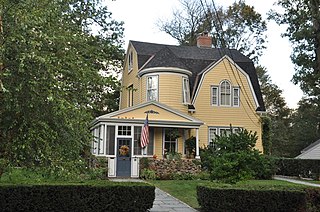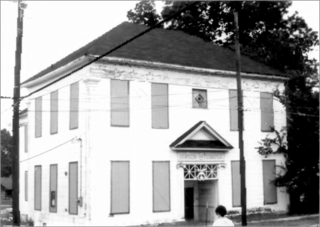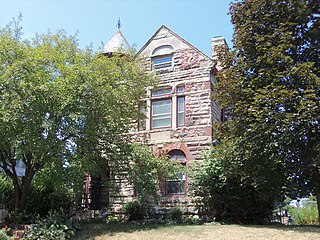
Meridian is the eighth most populous city in the U.S. state of Mississippi, with a population of 35,052 at the 2020 census. It is the county seat of Lauderdale County and the principal city of the Meridian, Mississippi Micropolitan Statistical Area. Along major highways, the city is 93 mi (150 km) east of Jackson; 154 mi (248 km) southwest of Birmingham, Alabama; 202 mi (325 km) northeast of New Orleans, Louisiana; and 231 mi (372 km) southeast of Memphis, Tennessee.

Merrehope, a 26-room Victorian mansion that currently serves as a historic house museum, was originally built in 1858 by Richard McLemore for his daughter Juriah Jackson. After changing ownership several times, with small alterations from each owner, the house was eventually bought by S.H. Floyd in 1904, who remodelled it into its present appearance. The building was one of few spared by General William Tecumseh Sherman on his raid of the city in the Battle of Meridian, and has served many functions throughout its history, including time as a residence, a shelter for Union officers, a Confederate General's headquarters, an apartment building, and a boarding house. The building was listed on the National Register of Historic Places in 1971 and as a Mississippi Landmark in 1995.

129 High Street in Reading, Massachusetts is a well-preserved, modestly scaled Queen Anne Victorian house. Built sometime in the 1890s, it typifies local Victorian architecture of the period, in a neighborhood that was once built out with many similar homes. It was listed on the National Register of Historic Places in 1984.

Cobblestone Farmhouse at 1229 Birdsey Road is a farmhouse in the town of Junius, New York, in Seneca County, New York. It is significant as a well-preserved example of cobblestone architecture, in a vernacular Greek Revival style. North of the house, there is also a large barn believed to date to the late 19th century. This property was listed on the National Register of Historic Places on August 6, 2008. It is the sixth property listed as a featured property of the week in a program of the National Park Service that began in July, 2008.

The House at 32 Morrison Road in Wakefield, Massachusetts is a well-preserved, architecturally eclectic, house in the Wakefield Park section of town. The 2+1⁄2-story wood-frame house features a gambrel roof with a cross gable gambrel section. Set in the front gable end is a Palladian window arrangement. The porch has a fieldstone apron, with Ionic columns supporting a pedimented roof. Above the front entry rises a two-story turret with conical roof. The house was built c. 1906–08, as part of the Wakefield Park subdivision begun in the 1880s by J.S. Merrill.

There are nine historic districts in Meridian, Mississippi. Each of these districts is listed on the National Register of Historic Places. One district, Meridian Downtown Historic District, is a combination of two older districts, Meridian Urban Center Historic District and Union Station Historic District. Many architectural styles are present in the districts, most from the late 19th century and early 20th century, including Queen Anne, Colonial Revival, Italianate, Art Deco, Late Victorian, and Bungalow.

The Harriet and Thomas Beare House is a Victorian house located on Reeves Drive in the Near Southside Historic District of Grand Forks, North Dakota. The Harriet and Thomas Beare House was added to the National Register of Historic Places in 1995. It is also known as the Margaret E. Bowler Murphy and Michael F. Murphy House.

The Fyler–Hotchkiss Estate, also known as the Hotchkiss-Fyler House Museum, is a historic house museum at 192 Main Street in Torrington, Connecticut. Operated by the Torrington Historical Society, its main house is a well-preserved and distinctive example of Chateauesque Victorian architecture. It is also significant for its association with Orsamus Fyler, a prominent local politician and businessman. The property was listed on the National Register of Historic Places in 2009.

The Masonic Temple at 1220 26th Avenue, Meridian, Mississippi was built in 1903. It was listed on the National Register of Historic Places in 1979. It was also listed as a contributing property to the Merrehope Historic District in 1988. It has since been demolished.
The Carnegie Branch Library at 13th St and 28th Ave in Meridian, Mississippi is one of two former Carnegie libraries in the city, both funded by a grant from Andrew Carnegie in 1904. This library was built for blacks while the other was built for whites. The other library was built at 25th Ave and 7th St and now houses the Meridian Museum of Art. Both buildings were listed on the National Register of Historic Places in 1979. The black library was demolished in 2008.

Hillside, also known as the Charles Schuler House, is a mansion overlooking the Mississippi River on the east side of Davenport, Iowa, United States. It has been individually listed on the National Register of Historic Places since 1982, and on the Davenport Register of Historic Properties since 1992. In 1984 it was included as a contributing property in the Prospect Park Historic District.

The Edward Edinger House is a historic building located in the West End of Davenport, Iowa, United States. It has been listed on the National Register of Historic Places since 1984.

Cody Road Historic District is a nationally recognized historic district located in Le Claire, Iowa, United States. It includes 60 buildings along a nine-block stretch of U.S. Route 67, Cody Road, the primary street through the town. The district contains Le Claire's main commercial district on the south side of the district and residential area on the north. The district has been listed on the National Register of Historic Places since 1979.

The Connor House is an historic building located in Rock Island, Illinois, United States. It was designated a Rock Island Landmark in 1987. The house was individually listed on the National Register of Historic Places in 1988, and it was included as a contributing property in the Broadway Historic District in 1998.

Causeyville, Mississippi is a small community in southeastern Lauderdale County, Mississippi, about twelve miles southeast of the city of Meridian. The Causeyville Historic District consists of four buildings at the center of the community — two general stores and two residences — that exemplify the pivotal contribution that small communities like Causeyville made to the development of Lauderdale County. The district was added to the National Register of Historic Places in 1986.
The numerous historic hotels in Meridian, Mississippi, provide insights into the city's growth and expansion, both in the late 19th and early 20th centuries and into the modern age. Many hotels were built in downtown Meridian in the early 1900s to provide lodging for passengers of the railroad, which was essential to the city's growth at the turn of the 20th century. Two of these historic hotels–the Union Hotel, built in 1910, and the Lamar Hotel, built in 1927–have been listed on the National Register of Historic Places.

Thornwell-Elliott House is a historic home located at Fort Mill, York County, South Carolina. It was built about 1877, and is a one-story, L-shaped frame dwelling in the Late Victorian style. The front façade features hip roofed porch with decorative brackets and turned balustrade.

The Medgar and Myrlie Evers Home National Monument, also known as Medgar Evers House, is a historic house museum at 2332 Margaret Walker Alexander Drive within the Medgar Evers Historic District in Jackson, Mississippi, United States. Built in 1956, it was the home of African American civil rights activist Medgar Evers (1925–1963) at the time of his assassination. It was designated a National Historic Landmark in 2017. The John D. Dingell, Jr. Conservation, Management, and Recreation Act, signed March 12, 2019, by President Donald Trump, authorized it as a national monument; it was established on December 10, 2020, after the National Park Service (NPS) acquired it from Tougaloo College.

Cathedral Historic District, originally the Sioux Falls Historic District, is located in Sioux Falls, South Dakota. Named for its centerpiece and key contributing property, the Cathedral of Saint Joseph, the district covers the neighbourhood historically known as Nob Hill, where multiple prominent pioneers, politicians, and businessmen settled in the late 19th and early 20th centuries. These homes primarily reflect Queen Anne and Mediterranean Revival architectural styles. In 1974, the neighborhood was listed as a historic district on the National Register of Historic Places (NRHP); at the time of this listing, there were 223 buildings, not all contributing, within the district's boundaries. The district was enlarged in 2023.




















